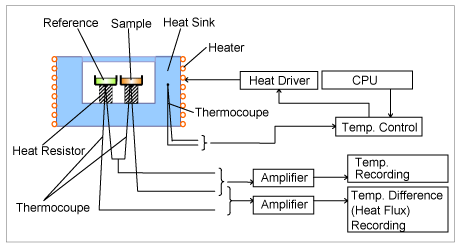Principle of Differential Scanning Calorimetry (DSC)
Definitions of Differential Scanning Calorimetry (DSC)
DSC is the generic term for the following two measurement methods.
-
Heat Flux DSCs
A technique in which the temperature of the sample unit, formed by a sample and reference material, is varied in a specified program, and the temperature difference between the sample and the reference material is measured as a function of temperature. -
Power Compensation DSC
A technique in which difference of thermal energy that is applied to the sample and the reference material per unit of time is measured as a function of the temperature to equalize their temperature, while temperature of the sample unit, formed by the sample and reference material, is varied in a specified program.
* This is definition of DSC by JIS (Japanese Industrial Standard)
Description of DSC

DSC is a commercially available instrument which has two (2) types: Heat Flux Type and Power Compensation Type. Figure 1 shows the block diagram of Heat Flux DSC as an example. Heat Flux DSC comprises the sample and reference holder, the heat resistor, the heat sink, and the heater. Heat of heater is supplied into the sample and the reference through heat sink and heat resistor. Heat flow is proportional to the heat difference of heat sink and holders. Heat sink has the enough heat capacity compared to the sample. In case the sample occurs endothermic or exothermic phenomena such as transition and reaction, this endothermic or exothermic phenomena is compensated by heat sink. Thus the temperature difference between the sample and the reference is kept constant. The difference the amount of heat supplied to the sample and the reference is proportional to the temperature difference of both holders. By calibrating the standard material, the unknown sample quantitative measurement is achievable.
DSC enables the measurements of the transition such as the glass transition, melting, and crystallization. Furthermore, the chemical reaction such as thermal curing, heat history, specific heat capacity, and purity analysis are also measurable. Recently, with the development of the highly-functional polymeric material, these thermal properties analysis needs are increasing dramatically. DTA and DSC detect the temperature differences between the sample and the reference; however, DSC can perform the quantitative measurement of the amount of heat on top.
Definitions of Thermal Analysis and Viscoelasticity
- Definitions of Thermal Analysis
- Definitions of Differential Scanning Calorimetry (DSC)
- Definitions of Thermogravimerty (TG)
- Definitions of Differential Thermal Analysis (DTA)
- Definitions of Thermomechanical Analysis (TMA)
- Definitions of Dynamic Mechanical Analysis (DMA)
